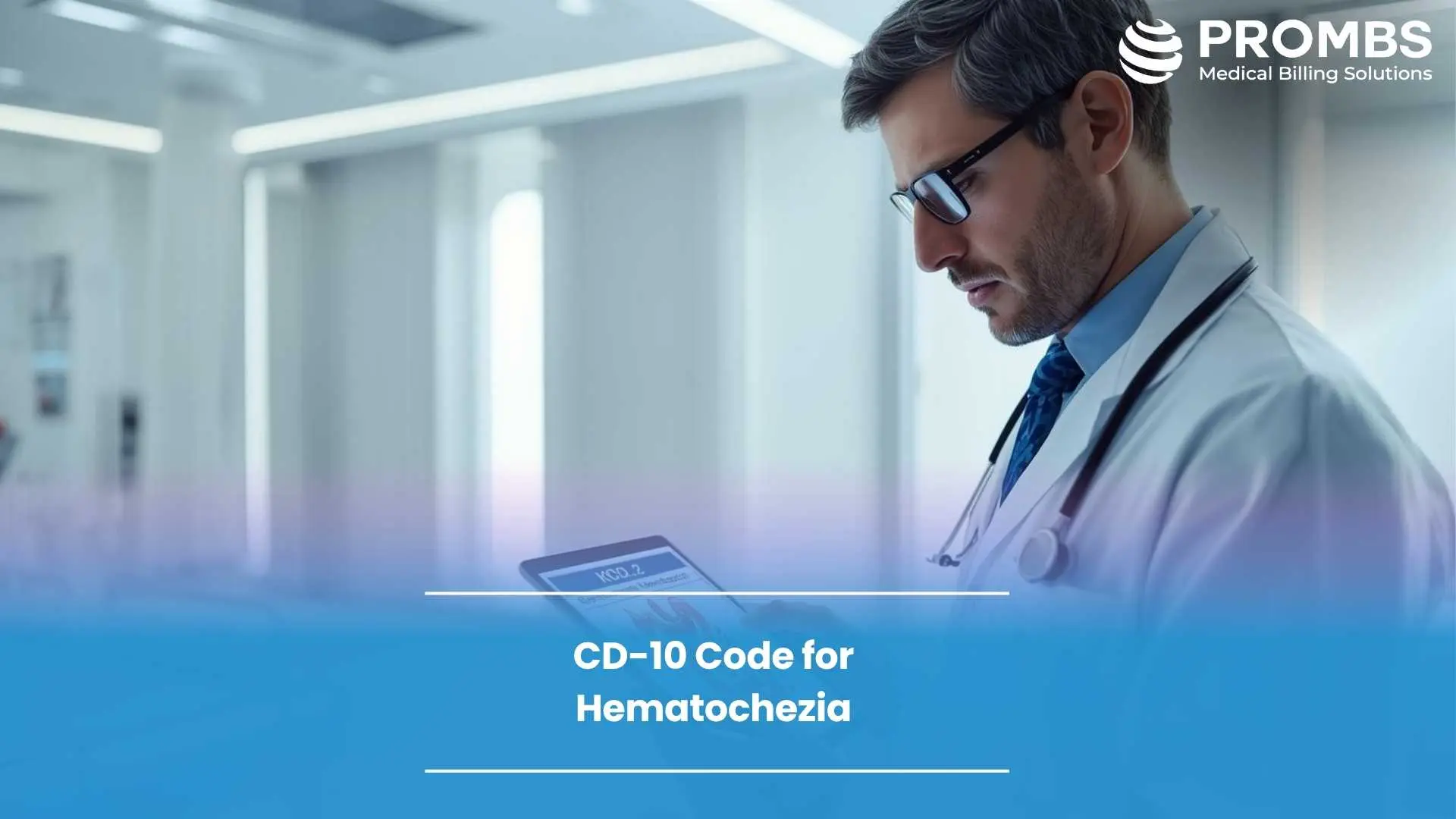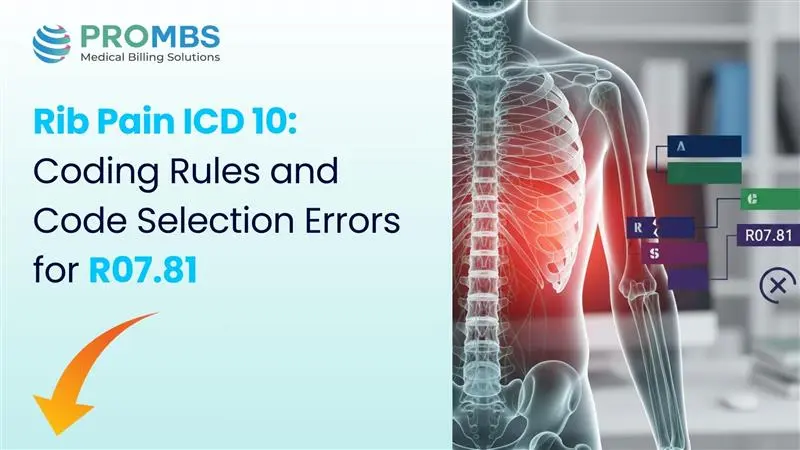Hematochezia refers to the passage of bright red blood per rectum, usually indicating bleeding from the lower gastrointestinal (GI) tract. It is a clinically significant symptom that can be associated with conditions such as diverticulosis, colorectal cancer, inflammatory bowel disease, or hemorrhoids. In medical billing, hematochezia is more than a clinical diagnosis, it is a coding and documentation challenge. Physicians may describe it differently in their notes, and coders must ensure that the right ICD-10 code is applied to avoid denials. According to the Centers for Medicare & Medicaid Services (CMS), gastrointestinal bleeding conditions are frequently involved in improper payments due to documentation gaps and unspecified coding.
For providers, capturing hematochezia accurately is critical because payers often scrutinize GI-related claims for medical necessity and proper diagnostic specificity. If coded incorrectly, claims may be flagged as incomplete or denied for insufficient clinical evidence. This is why the icd 10 code for hematochezia has significant implications for both clinical and billing workflows.
What Are the Symptoms of Hematochezia?
Hematochezia is clinically defined as the passage of bright red or maroon-colored blood per rectum, usually pointing to bleeding in the lower gastrointestinal tract. The most visible symptom is fresh blood mixed with or coating stool, but physicians also consider associated indicators such as abdominal pain, diarrhea, weakness, or changes in bowel habits. Unlike melena, which produces black, tarry stools due to upper GI bleeding, hematochezia generally signals bleeding closer to the colon, rectum, or anus.
According to the American College of Gastroenterology (ACG), patients may present with intermittent bleeding from hemorrhoids or more severe blood loss caused by diverticular disease or colorectal cancer.
From a medical billing and coding perspective, symptom clarity is crucial because payer scrutiny increases when GI bleeding is involved. If a provider simply writes “blood in stool” without further context, the claim may not justify the icd 10 code for hematochezia (K92.1). The American Health Information Management Association (AHIMA) emphasizes that stool description, source of bleeding, and associated conditions must be explicitly documented to differentiate hematochezia from melena (K92.2) or unspecified gastrointestinal hemorrhage (K92.2). Coders must always link the clinical symptom to supporting documentation to ensure reimbursement compliance.
| Symptom Indicator | Documentation Detail Needed |
|---|---|
| Bright red blood in stool | Specify “hematochezia” or “bright red rectal bleeding” to justify K92.1, as required by CMS GI coding guidance. |
| Abdominal pain with bleeding | Document duration and severity, especially when linked to diverticulitis or IBD per ACG practice standards. |
| Diarrhea with blood | Record frequency and associated conditions, since inflammatory bowel disease coding differs per AHIMA documentation guidelines. |
| Weakness, dizziness, anemia | Include laboratory findings to prove medical necessity for endoscopic procedures as advised by the AMA CPT rules. |
This table illustrates how each symptom is not only a clinical sign but also a coding determinant. Without precise details, payers may reject claims as unspecified or medically unnecessary, which is why ProMBS emphasizes symptom-driven documentation during claim preparation. A connecting factor between symptoms and claim approval is that documentation must demonstrate the clinical necessity of ordering diagnostic procedures such as colonoscopy or sigmoidoscopy. When hematochezia is presented with systemic symptoms like anemia or weakness, payers are more likely to approve higher-level CPT procedures. This is why symptom clarity in provider notes becomes both a medical and financial safeguard.
Did You Know? The Centers for Medicare & Medicaid Services (CMS) has identified GI bleeding conditions, including hematochezia, as one of the leading contributors to Medicare improper payments. Many of these errors are directly tied to insufficient or vague documentation of symptoms, which ProMBS addresses by embedding clinical detail audits into every coding workflow.
Understanding the ICD-10 Code for Hematochezia?
The official icd 10 code for hematochezia is K92.1, which is classified under Melena, hematochezia, and other specified gastrointestinal hemorrhage. While the clinical definition of hematochezia is the passage of bright red blood per rectum, ICD-10 groups this presentation under the category of gastrointestinal hemorrhage to distinguish it from hematemesis (K92.0) and unspecified GI hemorrhage (K92.2).
According to the American Academy of Professional Coders (AAPC), coders must carefully review the provider’s documentation to confirm that the bleeding originates from the lower GI tract before assigning K92.1. This distinction is critical because payers often deny claims coded as unspecified hemorrhage if the clinical documentation points to a more precise diagnosis such as hematochezia. The Centers for Medicare & Medicaid Services (CMS) instructs coders to always use the most specific ICD-10 code available, noting that unspecified codes like K92.2 are acceptable only when the medical record lacks sufficient detail. Using K92.1 instead of K92.2 reduces denial risk, improves clean claim rates, and demonstrates compliance with payer requirements for specificity.
| ICD-10 Code | Description | Documentation Requirement |
|---|---|---|
| K92.0 | Hematemesis (vomiting of blood) | Requires provider documentation of upper GI bleeding confirmed through history or endoscopy, per CMS coding rules. |
| K92.1 | Hematochezia (bright red rectal bleeding) | Must specify “bright red blood per rectum” in the record, consistent with AHIMA documentation standards. |
| K92.2 | Gastrointestinal hemorrhage, unspecified | Only to be used when clinical detail is absent or inconclusive, per AAPC coding guidelines. |
This table demonstrates why coders and billers must pay attention to subtle documentation differences. For example, if a provider documents only “GI bleed” without stating whether the source is upper or lower tract, coders may be forced to assign K92.2. This lack of specificity can increase denial rates and draw payer audits, especially since GI bleeding codes are flagged as high-risk in CMS improper payment reviews. The connection between clinical documentation and ICD-10 specificity highlights why coding hematochezia requires more than just a surface-level review of provider notes. ProMBS coders are trained to query physicians when documentation is insufficient, ensuring that the assignment of K92.1 is fully supported by clinical evidence. This proactive workflow prevents payer disputes and protects providers from compliance risks.
Did You Know? The Office of Inspector General (OIG) has identified overuse of unspecified diagnosis codes such as K92.2 as a red flag during audits, noting that repeated reliance on nonspecific coding may suggest systemic noncompliance. Assigning the precise icd 10 code for hematochezia (K92.1) not only improves claim approval rates but also strengthens compliance integrity for providers.
Which ICD-10 Chapter Includes Hematochezia?
The icd 10 code for hematochezia (K92.1) is located in Chapter XI of the ICD-10-CM: “Diseases of the Digestive System” (K00–K95). This chapter encompasses all disorders of the gastrointestinal tract, liver, gallbladder, pancreas, and related structures. The World Health Organization (WHO) designed this chapter to capture conditions that directly affect digestion and nutrient absorption, which is why gastrointestinal hemorrhage codes, including hematochezia, are grouped here. Understanding that K92.1 belongs to Chapter XI is more than an academic exercise. For coders and billers, placement within the digestive system chapter guides sequencing, payer expectations, and CPT linkage. The Centers for Medicare & Medicaid Services (CMS) specifies that when hematochezia is a symptom of another digestive condition, such as colorectal cancer or diverticulitis, the underlying condition must be sequenced first, with K92.1 coded as an additional diagnosis. This sequencing rule ensures that claims reflect the medical necessity of diagnostic and therapeutic procedures like colonoscopy or colectomy.
The American Health Information Management Association (AHIMA) emphasizes that failure to correctly apply chapter-based sequencing is one of the most frequent causes of claim rejections for gastrointestinal diagnoses. For example, if hematochezia is coded as the principal diagnosis during an inpatient stay when the true underlying cause is colon cancer, the claim may be denied for incorrect principal diagnosis assignment. Placement in Chapter XI underscores the need for coders to capture both the symptom and the underlying pathology whenever documented.
| ICD-10 Chapter | Code Range | Hematochezia Placement | Documentation Rule |
|---|---|---|---|
| Chapter XI: Diseases of the Digestive System | K00–K95 | K92.1 (Hematochezia) | Sequence as secondary diagnosis if linked to conditions such as colorectal cancer, per CMS sequencing guidelines. |
| Chapter II: Neoplasms | C00–D49 | Related when bleeding is caused by malignant tumors | Cancer is coded first, with K92.1 coded additionally if documented. |
| Chapter XIX: Injury, Poisoning | S00–T88 | Rare cases where trauma causes GI bleeding | Trauma diagnosis sequenced first, hematochezia as secondary if specified, per CMS coding guidance. |
This table shows that while hematochezia is placed firmly in Chapter XI, coders must also be aware of other chapters when the symptom is secondary to neoplasms or trauma. Proper chapter sequencing reflects clinical reality and strengthens claim defensibility during audits. By appreciating hematochezia’s placement in ICD-10, coders avoid one of the most common pitfalls in GI billing: treating a symptom code as the principal diagnosis when a more definitive diagnosis is available. ProMBS reinforces these chapter-based rules through compliance-driven audits that ensure correct sequencing before claims reach the payer.
Did You Know? The Office of Inspector General (OIG) has highlighted sequencing errors as a recurring compliance weakness, particularly in gastrointestinal claims. Incorrectly coding hematochezia as the primary diagnosis instead of sequencing it with the underlying condition can trigger audits and repayment demands. By aligning with ICD-10 chapter placement rules, providers safeguard both compliance and revenue integrity.
Which CPT Codes Pair with the ICD-10 Code for Hematochezia?
Assigning the icd 10 code for hematochezia (K92.1) alone is never sufficient for billing because payers require CPT or HCPCS codes that describe the diagnostic or therapeutic services performed to evaluate and treat the bleeding. According to the American Medical Association (AMA), CPT codes are designed to represent the procedures and services rendered, while ICD-10-CM codes like K92.1 provide the clinical justification. Proper linkage between ICD-10 and CPT is essential for establishing medical necessity, which the Centers for Medicare & Medicaid Services (CMS) identifies as one of the leading causes of claim denials when missing. For hematochezia, commonly associated CPT codes include colonoscopy, flexible sigmoidoscopy, anoscopy, and biopsy procedures. A patient presenting with bright red blood per rectum may undergo a diagnostic colonoscopy (CPT 45378) or therapeutic procedures such as colonoscopy with control of bleeding (CPT 45384). In some outpatient encounters, anoscopy (CPT 46600) may be used to evaluate hemorrhoids or fissures causing the bleeding. The key is that the icd 10 code for hematochezia must be documented in the provider’s note and linked to the CPT procedure to prove the service was clinically necessary.
| CPT Code | Description | Documentation Requirement |
|---|---|---|
| 45378 | Diagnostic colonoscopy | Must document hematochezia as the indication for the procedure per AMA CPT guidelines. |
| 45380 | Colonoscopy with biopsy | Requires clinical notes linking hematochezia to suspected pathology such as IBD or neoplasms, consistent with CMS documentation rules. |
| 45384 | Colonoscopy with control of bleeding | Used when active GI bleeding is found; medical record must specify control of hemorrhage consistent with CMS coverage determinations (LCD/NCD). |
| 46600 | Diagnostic anoscopy | Appropriate when hematochezia is due to hemorrhoids or anal fissures; documentation must specify findings as outlined in AMA CPT documentation standards. |
This table illustrates how CPT codes represent the procedures that justify reimbursement, while K92.1 demonstrates the clinical reason for performing them. Failure to link these two code sets correctly can trigger denials for “lack of medical necessity” or “procedure not justified by diagnosis,” which are among the most common GI billing rejections cited by the American Health Information Management Association (AHIMA). The connection between CPT and ICD-10 codes is not just administrative, it is compliance-critical. Payers such as Medicare require that procedure claims pass through National Correct Coding Initiative (NCCI) edits, which verify that the CPT service is clinically appropriate for the ICD-10 diagnosis. ProMBS ensures this compliance by scrubbing every claim through NCCI edits and
payer-specific LCDs before submission, protecting providers from denials and repayment demands.
Did You Know? The OIG has documented that a significant percentage of GI procedure denials occur because the ICD-10 code was either unspecified or not appropriately linked to the CPT service. By coding hematochezia accurately with K92.1 and linking it to the correct CPT procedure, providers can improve first-pass acceptance rates and reduce audit risk.
What Treatments Are Linked to Hematochezia?
The treatment of hematochezia depends on the underlying cause, severity of bleeding, and clinical setting. Mild cases caused by hemorrhoids or anal fissures may be managed conservatively, while severe bleeding due to diverticulosis, inflammatory bowel disease, or malignancies often requires urgent endoscopic or surgical intervention. The American College of Gastroenterology (ACG) emphasizes that hematochezia should always be investigated because it may be the presenting symptom of serious colorectal pathology.
From a billing standpoint, treatment documentation must capture not only the procedures performed but also the diagnostic linkage to the icd 10 code for hematochezia (K92.1). The American Medical Association (AMA) requires that CPT codes distinguish between diagnostic and therapeutic interventions. For example, colonoscopy for evaluation of rectal bleeding (CPT 45378) differs in reimbursement from colonoscopy with control of bleeding (CPT 45384). The Centers for Medicare & Medicaid Services (CMS) notes that payer medical necessity reviews will deny therapeutic procedures if the provider documentation does not demonstrate active bleeding or failed conservative treatment.
| Treatment Approach | Coding/Billing Consideration |
|---|---|
| Conservative care (e.g., hemorrhoid management, dietary adjustment) | Document clinical rationale for conservative treatment. No CPT may be required unless procedures are performed, but K92.1 should still be recorded. |
| Diagnostic colonoscopy (CPT 45378) | Must document hematochezia as the indication for the procedure per AMA CPT guidance. |
| Colonoscopy with biopsy (CPT 45380) | Required if bleeding is suspected to be linked to IBD, polyps, or neoplasms; biopsy must be justified in notes, consistent with CMS LCD standards. |
| Colonoscopy with control of bleeding (CPT 45384) | Used when hematochezia originates from active lower GI bleeding; provider must specify control method (clipping, cautery, injection), consistent with CMS LCD requirements. |
| Surgery (e.g., colectomy for malignancy) | Hematochezia coded as secondary to primary diagnosis (such as colon cancer); per AHIMA sequencing standards. |
The table makes it clear that treatment coding must always be tied to medical necessity and clinical documentation. Simply entering a procedure code without linking it to hematochezia can result in payer rejections for “diagnosis does not support service.” This is where ProMBS compliance workflows protect providers. Every treatment-based claim undergoes denial-prevention scrubbing, ensuring ICD-10 to CPT linkage is valid under payer rules, while AR follow-up teams track whether claims pass medical necessity audits. By aligning with HFMA denial prevention benchmarks, ProMBS improves first-pass claim acceptance and accelerates reimbursement for hematochezia-related care.
Did You Know? The OIG has documented that GI-related procedures are frequently audited under the False Claims Act when therapeutic interventions are billed without proper diagnostic linkage. This means that for hematochezia, claims coded with K92.1 but unsupported by clear clinical documentation carry both financial and compliance risks. ProMBS mitigates this exposure by embedding documentation integrity checks into every claim.
How Should Documentation Be Structured to Avoid Denials?
For gastrointestinal conditions like hematochezia, documentation is the single most important factor determining whether a claim is reimbursed or denied. Payers frequently reject claims when the medical record lacks specificity, fails to justify medical necessity, or omits sequencing details. The American Health Information Management Association (AHIMA) has stressed that vague terms such as “blood in stool” or “GI bleeding” without further clarification do not support the assignment of icd 10 code for hematochezia (K92.1). The Centers for Medicare & Medicaid Services (CMS) reports that gastrointestinal diagnoses remain among the top contributors to Medicare improper payments because of documentation insufficiency.
To prevent denials, documentation must be structured to capture the symptom detail, the underlying cause, and the sequence of diagnoses. For example, if hematochezia is secondary to colon cancer, the cancer must be listed as the primary diagnosis, with K92.1 coded additionally. The Office of Inspector General (OIG) has emphasized that repeated misuse of unspecified coding or incorrect sequencing can be viewed as systemic compliance weaknesses. ProMBS addresses this by embedding physician queries and denial-prevention audits into every coding workflow, ensuring claims are defensible before submission.
| Documentation Gap | Payer Denial Trigger | Structured Solution |
|---|---|---|
| Provider note only states “blood in stool” | Claim denied as vague or medically unnecessary | Document as “bright red blood per rectum” to support K92.1, consistent with AHIMA documentation guidelines. |
| Missing link between diagnosis and procedure | Denial for lack of medical necessity | Ensure colonoscopy CPT codes are explicitly tied to hematochezia as the indication, per AMA CPT rules. |
| Incorrect sequencing of diagnoses | Claim flagged during audit | Follow CMS sequencing requirements to list the primary condition first, with hematochezia as secondary. |
| Incomplete clinical evidence | Claim rejected for insufficient documentation | Include lab findings, anemia status, or stool description, per HFMA denial prevention standards. |
This table highlights how denial risks directly correlate with documentation weaknesses. ProMBS coders prevent these risks by ensuring that every claim is reviewed for completeness, specificity, and compliance before payer submission. Structured documentation not only improves first-pass acceptance but also protects providers during audits. When coders and providers collaborate through structured query processes, claims for hematochezia move from being high-denial risk to being clean, compliant submissions. This proactive approach reflects the HFMA’s guidance that denial prevention should happen at the front end of the revenue cycle rather than through reactive appeals.
Did You Know? The OIG has found that recurring documentation errors in gastrointestinal coding have led to False Claims Act settlements exceeding $50 million, often tied to repeated use of vague or unspecified hemorrhage codes. By structuring documentation around K92.1 with precision, ProMBS ensures providers are not only reimbursed but also protected from compliance exposure.
Why Should Providers Partner with ProMBS for Hematochezia Billing?
Accurately billing for gastrointestinal conditions like hematochezia requires more than assigning the icd 10 code for hematochezia (K92.1). It demands precision in documentation, compliant CPT linkage, payer-specific edits, and proactive denial prevention. Providers and billing companies often face high denial rates for GI-related claims because vague documentation or misapplied sequencing rules expose them to rejections and audits. The Healthcare Financial Management Association (HFMA) has noted that gastrointestinal diagnoses are among the top five categories associated with prolonged AR cycles due to improper coding. ProMBS addresses these challenges by embedding compliance and performance safeguards into every step of the billing cycle. Claims linked to hematochezia are scrubbed against CMS Local Coverage Determinations (LCDs) and National Correct Coding Initiative (NCCI) edits to ensure payer acceptance. Provider documentation is reviewed against AHIMA integrity standards so that every
claim reflects clear clinical justification. Denials are not just managed but prevented at the front end of the revenue cycle, aligning with HFMA’s best practice guidance for reducing avoidable claim rejections.
Partnering with ProMBS means providers are supported by billing experts who not only understand ICD-10 and CPT codes but also integrate compliance requirements from CMS, OIG, and DOJ into
everyday workflows. That combination of technical accuracy and compliance rigor ensures hematochezia claims are processed faster, reimbursed more consistently, and defended more effectively during audits.
Did You Know? The Department of Justice (DOJ) has prosecuted providers under the False Claims Act when repeated denials and improper billing patterns suggested systemic negligence. By outsourcing hematochezia claims management to ProMBS, providers gain not only financial efficiency but also protection against compliance liability.



